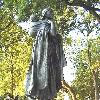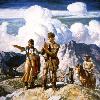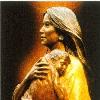

Sakakawea Statue. Bismarck, ND, 2004 - in front of Capitol Building Tags: Sacagawea View |
Tags: Sacagawea View |
Tags: Sacagawea View |
|||||||||
Sacagawea (also Sakakawea, Sacajawea; prons?ka???wi??Dubiousdate=July 2009 see below (#Name)) (c. 1788 - December 20, 1812; see below (#An 1884 death?) for other theories about her death) was a Lemhi (Lemhi Shoshone) Shoshone woman, who accompanied the Lewis and Clark Expedition, acting as an interpreter and guide, in their exploration of the Western United States. She traveled thousands of miles from North Dakota to the Pacific Ocean between 1804 and 1806. Clark nicknamed her Janey.
Reliable historical information about Sacagawea is very limited. She has become an important part of the Lewis and Clark mythology in the American public imagination. The National American Woman Suffrage Association of the early twentieth century adopted her as a symbol of womens worth and independence, erecting several statues and plaques in her memory, and doing much to spread the story of her accomplishments.
In 2000, the United States Mint issued the Sacagawea dollar coin in her honor, depicting Sacagawea and her son, Jean Baptiste Charbonneau. The face on the coin was modeled on a modern Shoshone-Bannock woman named RandyL He-dow Teton. No contemporary image of Sacagawea exists.
Birth Location: Lemhi River Valley,(near present-day Salmon, Idaho, Salmon, Idaho)
Date of death: 1812-12-20
Death Location: Fort Lisa (North Dakota), Fort Lisa, present-day North Dakota (probable)
Ethnicity: American Indian (Native Americans in the United States) (Shoshone)
Allias Name: Sakakawea, Sacajawea, Sakagawea
Known For: Accompanied the Lewis and Clark Expedition
Spouse: Toussaint Charbonneau
Children: Jean Baptiste Charbonneau Lizette Charbonneau



